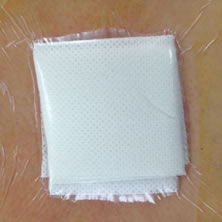- Home
- Post-Op Instructions

- Home
- Post-Op Instru...
Post-Op Instructions
Caring for Your Incision After Surgery
AFTER YOU LEAVE THE HOSPITAL OR SURGERY CENTER
- Your incision will be covered by gauze and a clear adhesive bandage called an “op-site”
- Leave this dressing on for 14 days after your surgery.
- The “op-site” is waterproof, and you may not shower over this dressing for 14 days.
- DO NOT SUBMERGE THE INCISION UNDER WATER SUCH AS IN A BATHTUB, HOTTUB, OR POOL.
- This clear adhesive is also called a Tegaderm (made by 3M) and can be found in most drug stores.
- If the gauze gets wet from the shower or from drainage from the incision,call on nursing staff to replace the dressing with clean, dry gauze.
CALL FOR ASSISTANCE ON +91 8889744443 IF YOU DEVELOP ANY OF THE FOLLOWING:
Increased pain, redness, drainage, swelling, or bleeding at the incision site.
Separation of the skin edges.
Fever of 100.4 or higher.
TWO WEEK AFTER SURGERY
- Your appointment with the doctor is scheduled 14 days after surgery, you can confirm a day prior for timing on appointment desk no. +91 8889744448
- Suture removal is done usually only this day.
- Doctor will advise you to take bath/shower now onwards.
- If you have a neck or back brace, remove the brace during shower.
Activities at Home After Surgery
General Activities:
Early, appropriate activity at home usually speeds up the recovery for most patients. Lying in bed for two weeks after surgery is not a good idea. Inactivity can lead to problems such as bed sores, blood clots in the legs, and pneumonia. That being said, there is a fine line between getting better and doing too much. Your body will tell you when you have overdone it, by either fatigue or increased pain. It takes some time for you to figure out what is too much, and of course, that may vary with the type of surgery that you have had.
You should be able to take care of yourself very soon following your procedure, and you won’t need to have a family member present at all times. You may need some assistance preparing food, checking wound, or getting groceries from market , but full-time care will not be necessary in most cases.
Here are some activity tips for maximizing your recovery:
- Doctor and his staff will let you know, based on what kind of surgery you have had, when you can resume these activities.
- Forward bending, sitting on floor and Heavy weight lifting should not be done untill your doctor allows you for these.
- Limit your pushing and pulling activities such as vacuuming, sweeping, mowing, and mopping floors for at least six weeks.
- If you feel more pain than usual after an activity, you may have overdone it. Take it a little easier for a few hours.
Walking:
- You should begin walking short distances immediately after surgery.
- Choose a level path for walking. Do not walk on hills.
- Start with 10 minutes twice a day, and work up from there. Once you are walking 20 minutes in one session, you can decrease your walk to just once a day. Your goal is 30-40 minutes/day.
- Let pain be your guide. What we mean by this is, if you have increased your walking time to 25 minutes from 20 minutes, and you experience severe pain, go back to 20 minutes for a few more days before trying to increase it again.
Lifting:
- No lifting anything heavier than 1-2 kg for the first 4 weeks after surgery. This is equal to a gallon of milk.
- Always lift with your legs and not your back. Keep whatever you are lifting as close to your body as possible.
- Bend your knees and keep your back straight when picking up small items off the floor.
Driving:
- Do not drive until you have been cleared to do so by your doctor.
- Never drive if you have been taking narcotic pain medication or muscle relaxants.
Sexual Activity:
Back and neck pain can interfere with your sex life, but we want you to resume normal relations with your partner as soon as possible after surgery. We recommend avoiding sex for six weeks after surgery. Once you have begun the healing process, use the position that is most comfortable.
Special Precautions Depending on your Type of Surgery
If You Have Had Cervical Fusion Surgery:
- Try to avoid excessive neck motion. Do not look up toward the ceiling and limit turning your neck from side to side to 30-degrees in each direction.
- Small amounts of motion are OK. If you try to hold your neck too stiff, your muscles in the back of your neck and shoulders will fatigue and start to spasm.
- Wear the soft cervical collar at all times (except for showering and eating) until Doctor has notified you that you may discontinue wearing it. When you remove the collar to shower or eat, keep your head in a neutral position, facing forward.
If You Have Had Lower Back Surgery (Microdiscectomy or Laminectomy):
- You may sit in a recliner or on a couch with a rolled-up towel or pillow for lumbar support for as long as you are comfortable.
- On longer car trips, get out and walk around for ten to fifteen minutes every hour. A reclining position will be most comfortable on longer trips.
- NO “BLT” (bending, lifting, or twisting). Do not bend at the waist, lift anything over 2-3 kg, push, pull or twist until cleared to do so.
Caring for Your Incision After Surgery



